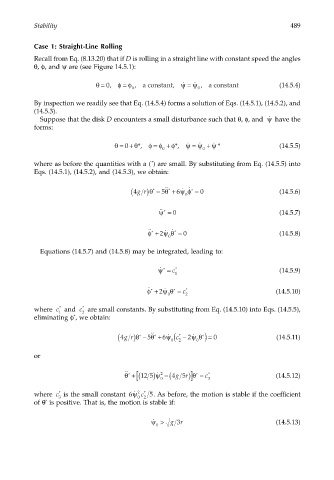Page 508 - Dynamics of Mechanical Systems
P. 508
0593_C14_fm Page 489 Tuesday, May 7, 2002 6:56 AM
Stability 489
Case 1: Straight-Line Rolling
Recall from Eq. (8.13.20) that if D is rolling in a straight line with constant speed the angles
θ, φ, and ψ are (see Figure 14.5.1):
θ = 0, φ = φ , a constant, ψ ˙ = ψ ˙ , a constant (14.5.4)
0 0
By inspection we readily see that Eq. (14.5.4) forms a solution of Eqs. (14.5.1), (14.5.2), and
(14.5.3).
Suppose that the disk D encounters a small disturbance such that θ, φ, and ˙ ψ have the
forms:
θ =+ θ*, φ = φ + φ*, ψ = ˙ ψ (14.5.5)
˙
0
ψ + ˙ *
0 0
*
where as before the quantities with a ( ) are small. By substituting from Eq. (14.5.5) into
Eqs. (14.5.1), (14.5.2), and (14.5.3), we obtain:
( 4gr)θ * − 5θ * ˙˙ + ˙ ˙ * = 0 (14.5.6)
6ψ φ
0
˙˙ *
ψ= 0 (14.5.7)
˙ ˙ *
˙˙*
φ +2 ψ θ = 0 (14.5.8)
0
Equations (14.5.7) and (14.5.8) may be integrated, leading to:
˙ *
ψ= c * (14.5.9)
1
˙ *
*
φ +2 ˙ ψ θ = c * (14.5.10)
0 2
where c * and c * are small constants. By substituting from Eq. (14.5.10) into Eqs. (14.5.5),
1 2
*
eliminating φ , we obtain:
6 (
( 4gr)θ * − 5θ * ˙˙ + ψ ˙ 0 c − ˙ 0 * ) = 0 (14.5.11)
2ψ θ
*
2
or
θ + ( [ ˙ ψ ) 5 2 θ )] * *
˙˙*
5
12
0 −(4gr = c 3 (14.5.12)
2
where c * is the small constant 6 ˙ ψ c * 5 . As before, the motion is stable if the coefficient
3 0 2
*
of θ is positive. That is, the motion is stable if:
3
˙ ψ > gr (14.5.13)
0

